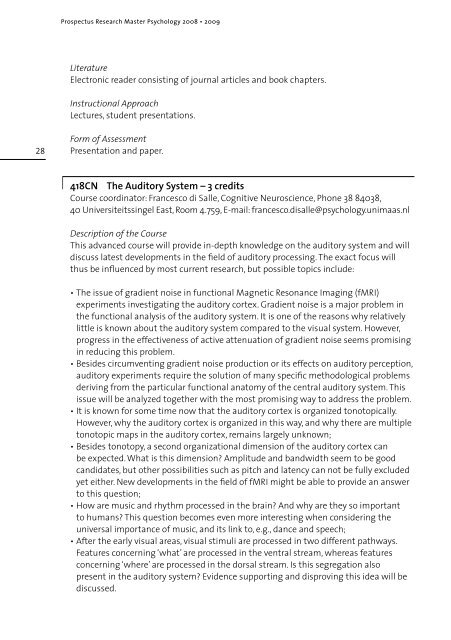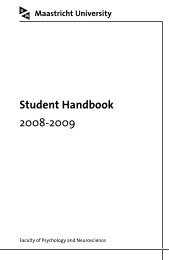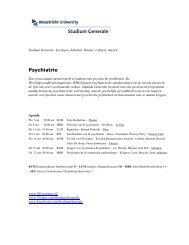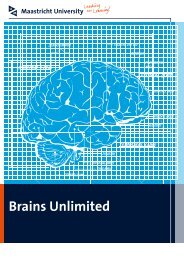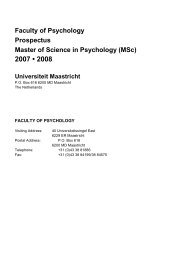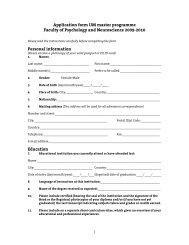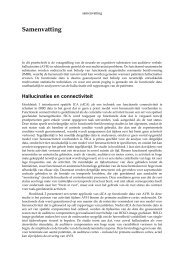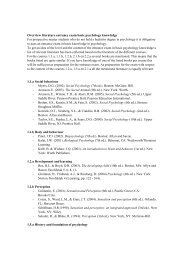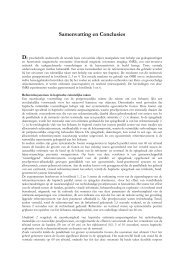Prospectus | 08/09 - Psychology and Neuroscience - Maastricht ...
Prospectus | 08/09 - Psychology and Neuroscience - Maastricht ...
Prospectus | 08/09 - Psychology and Neuroscience - Maastricht ...
You also want an ePaper? Increase the reach of your titles
YUMPU automatically turns print PDFs into web optimized ePapers that Google loves.
<strong>Prospectus</strong> Research Master <strong>Psychology</strong> 20<strong>08</strong> • 20<strong>09</strong><br />
Literature<br />
Electronic reader consisting of journal articles <strong>and</strong> book chapters.<br />
Instructional Approach<br />
Lectures, student presentations.<br />
28<br />
Form of Assessment<br />
Presentation <strong>and</strong> paper.<br />
| 418CN The Auditory System – 3 credits<br />
Course coordinator: Francesco di Salle, Cognitive <strong>Neuroscience</strong>, Phone 38 84038,<br />
40 Universiteitssingel East, Room 4.759, E-mail: francesco.disalle@psychology.unimaas.nl<br />
Description of the Course<br />
This advanced course will provide in-depth knowledge on the auditory system <strong>and</strong> will<br />
discuss latest developments in the field of auditory processing. The exact focus will<br />
thus be influenced by most current research, but possible topics include:<br />
• The issue of gradient noise in functional Magnetic Resonance Imaging (fMRI)<br />
experiments investigating the auditory cortex. Gradient noise is a major problem in<br />
the functional analysis of the auditory system. It is one of the reasons why relatively<br />
little is known about the auditory system compared to the visual system. However,<br />
progress in the effectiveness of active attenuation of gradient noise seems promising<br />
in reducing this problem.<br />
• Besides circumventing gradient noise production or its effects on auditory perception,<br />
auditory experiments require the solution of many specific methodological problems<br />
deriving from the particular functional anatomy of the central auditory system. This<br />
issue will be analyzed together with the most promising way to address the problem.<br />
• It is known for some time now that the auditory cortex is organized tonotopically.<br />
However, why the auditory cortex is organized in this way, <strong>and</strong> why there are multiple<br />
tonotopic maps in the auditory cortex, remains largely unknown;<br />
• Besides tonotopy, a second organizational dimension of the auditory cortex can<br />
be expected. What is this dimension? Amplitude <strong>and</strong> b<strong>and</strong>width seem to be good<br />
c<strong>and</strong>idates, but other possibilities such as pitch <strong>and</strong> latency can not be fully excluded<br />
yet either. New developments in the field of fMRI might be able to provide an answer<br />
to this question;<br />
• How are music <strong>and</strong> rhythm processed in the brain? And why are they so important<br />
to humans? This question becomes even more interesting when considering the<br />
universal importance of music, <strong>and</strong> its link to, e.g., dance <strong>and</strong> speech;<br />
• After the early visual areas, visual stimuli are processed in two different pathways.<br />
Features concerning ‘what’ are processed in the ventral stream, whereas features<br />
concerning ‘where’ are processed in the dorsal stream. Is this segregation also<br />
present in the auditory system? Evidence supporting <strong>and</strong> disproving this idea will be<br />
discussed.


